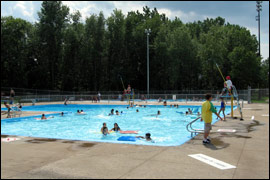Recreational Water Safety
 Public pools, wading pools and whirlpools are great places to have fun.
It the responsibility of the facility operators to ensure that pools are being maintained carefully to avoid the
spread of disease and to prevent safety hazards.
Public pools, wading pools and whirlpools are great places to have fun.
It the responsibility of the facility operators to ensure that pools are being maintained carefully to avoid the
spread of disease and to prevent safety hazards.
In Manitoba, public and semi-public swimming pools are regulated under the Swimming Pools and Other Water Recreational Facilities Regulation (MR 132/97). They are inspected and issued operating permits by Public Health Inspectors to ensure compliance with the regulation and to prevent the spread of communicable disease.
Pools and hot tubs must be disinfected on an ongoing basis. It is the responsibility of the facility operator to ensure that they are operated properly. Although ozone and bromine are occasionally used, chlorine is the most commonly-used chemical to disinfect pools. Chlorine will combine with organic compounds in a pool, and when it does, this will result in that “pool odour” we associate with chlorine. “Free” chlorine doesn’t smell, and it is more effective in killing bacteria and viruses.
Some things Public Health Inspectors look for at pools and hot tubs:
 A “free chlorine residual” of between 1.0 and 5.0 parts per million to kill bacteria and viruses.
A “free chlorine residual” of between 1.0 and 5.0 parts per million to kill bacteria and viruses. - A pH (measure of acidity) of between 7.2 and 7.8 to ensure the chlorine will work effectively.
- Bacterial sample results showing no total coliforms and no “Pseudomonas” (soo-doh-MOH-nas) bacteria – (Pseudomonas can cause an itchy rash & ear infections).
- That the operator is maintaining a record of chlorine and pH readings.
- That there is a first aid kit and a working telephone on site.
- That the water is not murky or cloudy.
- That depth markings are visibly marked on the side of the pool.
- That the physical pool structure is well maintained.
Hot Tub Health & Safety Tips:
- Children can overheat quickly and easily – monitor their time in a hot tub carefully.
- Do not use a hot tub after drinking alcohol – there is a danger of falling asleep and drowning.
- Pregnant women should be careful, and limit their time in a hot tub.
- Keep hot tub temperatures at no more than 40°C (104°F).
- Monitor chlorine levels often – the heat will drive chlorine off more quickly.
Do you want to construct a commercial pool or hot tub?
If you are planning to construct a pool at a motel or resort, contact an architect or engineer, who will work with you to develop a design. Submit drawings for the Public Health Inspector to review, which is a requirement prior to construction. You will also need an operating permit from your health inspector. Click here for a copy of the application form for new pool constructions or alterations.
Artificial Lake Safety
A safely operated artificial lake adds value to a community, minimizes incidents, and provides safe recreational opportunities for patrons and the general public. Guidelines for Artificial Lakes have been developed to increase the safety for the users of these man-made lakes. These lakes have similarities to natural bodies of water but also have important differences. The public and organizations operating businesses on artificial lakes should be aware of these guidelines and should make every effort to follow them. These guidelines focus on reducing the risk of drowning and reducing the risk of illness due to water quality issues and should also be considered by the public and operators of businesses on artificial lakes.
Recreational Water Technical Safety Bulletins
Swimming pools and other water recreational facilities throughout Manitoba are owned, managed and operated by a variety of organizations ranging from municipalities who operate large public pools and/or aquatic facilities, down to small semi-public pools operated at apartment blocks, condominiums and hotels. Although, these facilities range in complexity from simple swimming pools to splash pads, waterslides or a variety of other recreational water facilities, the health and safety of Manitobans using these facilities is always a top priority.
As such, the following links provide Technical Safety Bulletins discussing common issues related to the operation of these facilities and will be focussing on reducing the risk of drowning, injury and reducing the risk of recreational water illness due to water quality issues. These Bulletins will highlight regulatory requirements related to these issues.
- Requirements for Microbial Analysis of Water Samples from of Public and Semi-Public Recreational Water Facilities throughout Manitoba (Technical Safety Bulletin 01-2022)

- Pool Fences and Access Control (Technical Safety Bulletin 01-2021)

- Entrapment Prevention at Public and Semi-Public Water Recreational Facilities throughout Manitoba (Technical Safety Bulletin 01-2023)

Links
- Swimming Pools and Other Water Recreational Facilities Regulation (MR 132/97)
- Schedule A (Section 7) of the Swimming Pools and Other Water Recreational Facilities Regulation

- Pool Permit Renewal Form

- Fecal and Vomit Incident Protocol

- Diaper Requirements in Pools

- Routine Swimming Pool Inspection Safety & Sanitation Checklist

- Water Sampling Guidelines for Swimming Pools

- New Pool Construction/Alteration Application Form



